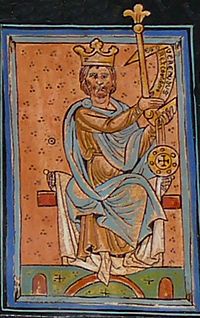Bermudo II of León facts for kids
Quick facts for kids Bermudo II |
|
|---|---|

Bermudo II in the Libro de las Estampas
|
|
| King of León | |
| Reign | 984–999 |
| Predecessor | Ramiro III |
| Successor | Alfonso V |
| King of Galicia | |
| Reign | 982–999 |
| Predecessor | Ramiro III |
| Successor | Alfonso V |
| Born | c. 953 |
| Died | c. 999 |
| Burial | Monastery of Carracedo later Basilica of San Isidoro |
| Consort | Velasquita Ramírez Elvira García |
| Issue | Alfonso V |
| Dynasty | Astur-Leonese dynasty |
| Father | Ordoño III of León |
| Mother | Urraca Fernández (?) |
| Religion | Chalcedonian Christianity |
Bermudo II (born around 953, died in September 999) was a king in what is now Spain. He was sometimes called the Gouty (Spanish: el Gotoso) because of a painful illness. He first ruled as a rival king in Galicia (982–984). Later, he became the king of the entire Kingdom of León (984–999).
His time as king was very challenging. A writer named Justo Pérez de Urbel described him as "the poor king tormented in life by the sword of Almanzor." Almanzor was a powerful Muslim leader who often attacked Bermudo's kingdom.
Becoming King
In 982, some important people in Galicia chose Bermudo as their king. They did this because they were against his cousin, Ramiro III, who was the current king. This disagreement over who should rule had been going on for many years.
Bermudo was crowned king in the cathedral of Santiago de Compostela on October 15, 982. Some church leaders who didn't support his crowning were sent away to monasteries.
Challenges and Conflicts
Bermudo's support was not very strong, and it was limited to certain areas. Because of this, he sometimes needed help from the Caliphate of Córdoba, a powerful Muslim state. However, the armies of Almanzor from Córdoba often came as invaders, not as friends.
There was a lot of trouble in Castile during Bermudo's early years. Between 991 and 992, Bermudo was even forced out of his kingdom by a rebellion. But he soon returned and made peace with the people who had rebelled.
Bermudo managed to take back the city of Zamora from the Muslims. But he couldn't completely push them out until 987. This made Almanzor angry, and he attacked Bermudo's lands in return.
Almanzor's forces besieged and destroyed the city of León. Bermudo had to escape and find safety in Zamora. The Muslim armies continued their attacks, capturing Astorga in 996 and destroying Santiago de Compostela in 997.
Later Life and Death
By 999, Bermudo's gout became very bad. It was so painful that he couldn't ride a horse anymore. As a military leader, he had to travel in a special carriage carried by others.
Later that same year, King Bermudo II died in Villanueva del Bierzo. He was first buried in the Monastery of Carracedo. Later, his body was moved to the Basilica of San Isidoro.
Family and Children
Bermudo II was the son of King Ordoño III of León. His mother was likely Urraca Fernández.
Bermudo had children from two marriages and also some children outside of marriage.
His first wife was Velasquita Ramírez. With her, he had a daughter named Cristina. Cristina later married Ordoño Ramírez, who was the son of Bermudo's rival, Ramiro III.
His second wife was Elvira García, whose father was a powerful count from Castile. With Elvira, Bermudo had three children:
- Alfonso, who became king after his father.
- Theresa
- Sancha
Bermudo also had three other children: Elvira, Pelayo, and Ordoño.
See also
 In Spanish: Bermudo II de León para niños
In Spanish: Bermudo II de León para niños

